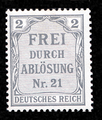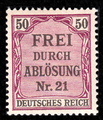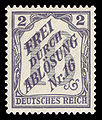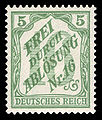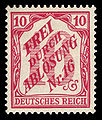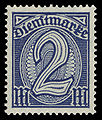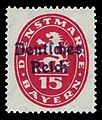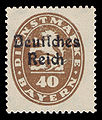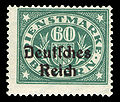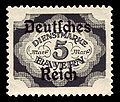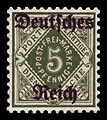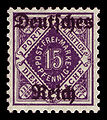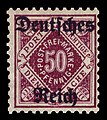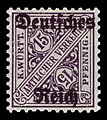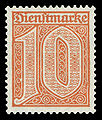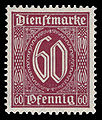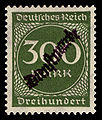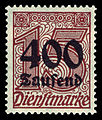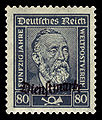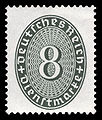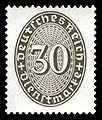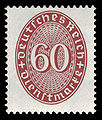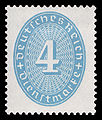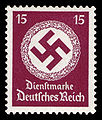Official stamps (German Empire)
In the German Reich, official stamps were stamps that were used exclusively by authorities , offices, offices and courts to frank postal items from official mail. From 1938 until the surrender in 1945 , the NSDAP party offices had their own series of badges. Prior to this, official stamps were also used temporarily by the savings banks .
Independent official stamps existed in Bavaria (1908 to 1920), Württemberg (1875 to 1920), the North German Confederation (1870 to 1871) and in the Free City of Danzig (1921 to 1927).
In the Federal Republic there were no more official stamps. In the GDR, items from state organs, administrations and companies had to be franked with official stamps from August 15, 1954 .
List of official stamps
Obverse numbers from 1870
State governments and individual agencies concluded postage replacement agreements with the Reichspost from 1870 to March 31, 1920, which were given a serial number, for example: 'No. 21 '= Prussia (for a detailed list, see the following table). In order to benefit from postage-free delivery, the items had to be provided with obverse slips (aversum = compensation, redemption) or similar notations (by stamp or handwritten), plus the official seal, which was often left out.
Only stamps or handwritten notes (2, 10, 12, 16–18, 23–34) are known of the obverse contract numbers not listed. Other agencies, state governments, free cities were not allowed to use obverse or replacement notices, they used the stamp Service item subject to postage .
1874
From July 1, 1874, there were fee slips for service letters of the railway, which were printed on yellow paper using the letterpress process. The notes said: Free according to the compensation account . A distinction must be made here between general editions (double-line edging) and so-called OPD editions with a single edging (without auxiliary line). The fee slips were delivered from the general post office to the individual upper post offices and distributed by them to the individual post offices. There was an obligation to use every service broadcast by the railways. The individual postage amounts were accounted for (hence the “compensation account ”) and billed to the railway administration on a monthly basis . A separate cancellation of the stamp was not intended, therefore genuinely canceled items are extremely rare.
1903 to 1905
The official stamps issued in Prussia in 1903 and in Baden in 1905 were used to determine the actual postage amounts for official mail within the two countries in order to reset a lump sum to be paid to the Reichspost .
When designing the stamp, the Germania definitive stamp series was used on the stamp frame .
In the case of the issue for Prussia , the stamp frame read Frei by redemption no.21 . The eight stamps were only valid within 1903.
- Edition for Prussia
In the issue for Baden , the stamp frame read Frei by Replacement No. 16 in oblique font. The six stamps were only valid within 1905.
- Edition for bathing
1920
From April 1, 1920 there was a new series consisting of seven values with the replacement number 21 for Prussia in the corners. Which was also made using the letterpress process, with the watermark diamond with a comb perforation of 14:14 1/4 (Michel numbers: 16 to 22). These were also used by non-Prussian authorities from July 1st.
Also from April 1, 1920, the general editions for all countries appeared in the same drawing , but without the 21. The printing process including the watermark is identical (Michel: 23 to 33).
Official stamps with the imprint "CGHS" come from Upper Silesia.
In addition, on April 1, 1920, so-called temporary editions appeared; these were former official stamps from Bavaria (44 to 61), which were provided with a two-line imprint "German Reich" from the printing company FA Bruckmann (Michel 34 to 51).
On the same day newly printed official stamps were issued in Württemberg, which were also provided with a two-line imprint "Deutsches Reich" from the printers of the transport authorities in Stuttgart (Michel 52 to 56). Other stamps with overprint were also produced for official traffic (Michel 57 to 64).
1921
The earliest proven use of the Michel number 65 is February 5, 1921 in Darmstadt with the punching "FM" (Ministry of Finance). The badge is the same as the number 24, but in a different color. This was produced as a roll stamp in the letterpress process with a comb perforation of 14:14 1/4 and the watermark Rauten.
In May a supplementary value of 60 Pfennig (Michel number 66) to the Michel numbers 23 to 33 appeared in a new drawing. The manufacturing process was the same except for the roll.
1922
In January and November 4 supplementary values of 75 pfennigs, 2 marks, 3 marks and 10 marks were issued for the series of numbers
1923
Formally, all official stamps below 100 marks were valid until September 30, 1923, from 100 to 800,000 marks until November 30, and values from 1 million marks until December 31, 1923. However, the inflation that exploded in autumn required up to the currency reform on November 15, 1923, values of up to 100 billion marks for franking.
- Four additional values for the series of digits
- Series of new values with service stamp overprint
- 1st series of values imprinted with official stamp during inflation
- 2. Series of values with value correction imprint during inflation
After the currency reform, six new official stamps were issued in the new currency Rentenmark on December 1, 1923 . The normal letter postage of ten billion " paper marks " (November 15, 1923) has now increased to ten Rentenpfennig (December 1, 1923).
- 1st series of values with imprint official stamp after the currency reform
1924
In the series of official stamps, which appeared from March 1924 and consisted of new values, the postage stamps Michel numbers 355 to 363 were used and the word official stamp was printed in a serpentine form either diagonally or horizontally.
Michel numbers:
- 105 to 110 as well as 112 and 113 valid until December 31, 1933.
- 111 valid until June 30, 1934
1927 to 1933
Between 1927 and December 1933, the series of official digits with the so-called straw hat pattern was published using letterpress printing on coated paper with watermarks, waffles and 14:14 1/4 teeth. The Michel numbers 114 to 131 were valid until December 31, 1936.
1934
The official stamps for state (government) authorities were designed in one color, the motif was the same for all twelve stamps, it showed the swastika in an oak wreath . These stamps were watermarked with swastikas . The set of service stamps served as a template for the later set from 1942, only partially changed colors and without watermarks. The stamps appeared from January 18, 1934 and were valid until the surrender in 1945. The brands could be purchased at the collective counters 'Berlin W 30' and 'Munich 2'.
The temporary use of official stamps by the savings banks of the time is also known.
1938
The badges for party offices showed the party eagle facing left on a pedestal. This set of eleven values was designed by Richard Klein . The stamps were produced using the letterpress process in a size of 21.5 × 26 mm with a comb perforation of 14 and the watermark 'swastika'. The stamps appeared on January 26, 1938 and were valid until the surrender in 1945. From January 31, 1938, unstamped official stamps were handed in at the Berlin W30 collective counter. Cancellation of courtesy was not permitted. From August 1, 1938, the NSDAP's official stamps were also valid in Austria .
1942 to 1944
The badges for party offices showed the party eagle facing left on a pedestal. This set of official stamps with eleven values is similar to the set from 1938, only partially slightly changed colors, but in contrast to the latter without watermark. The design comes from Richard Klein, the stamps appeared on March 2, 1942 and were valid until the surrender in 1945.
The official stamps for state (government) authorities showed the swastika in an oak wreath . This set, consisting of twelve stamps, is similar to the one from 1934, only partially slightly changed colors, but in contrast to the latter without watermark. An exact first issue date of 1942 is not known. The stamps could be used until the surrender in 1945.
After the Second World War , the existing stamps were provided with blackening for a short time as emergency aid to make the National Socialist symbols unrecognizable so that they could be used in normal postal traffic.
Remarks
- ↑ A. Beck Städt in "The German Postal Specialist" from 1961 numbers 6 and 8. FIG.
- ^ Michel-Spezial 1999, p. 395, after Dipl-ing. Eduard Peschl, INFLA
- ↑ Postage stamps in the period of inflation
- ^ Letter from a savings bank with official stamps dated April 13, 1937 ( page no longer available , search in web archives ) Info: The link was automatically marked as defective. Please check the link according to the instructions and then remove this notice.
literature
-
Michel catalog
- Germany special 1999.
- Germany 2006/2007 (paperback), Schwaneberger Verlag GmbH (2006), ISBN 3-87858-035-5 .
- Wolfgang Lotz; Stamps for the party - the official stamps of the NSDAP; in Das Archiv , Ed .: DGPT , Issue 1/2011 , ISSN 1611-0838 , pp. 38–40.
- Karl Sautter ; History of the Deutsche Post - Part 3: History of the Deutsche Reichspost 1871 to 1945; Bundesdruckerei, Frankfurt am Main, 1951; Pp. 561-562.
Web links
- Online catalog with comments and ratings

